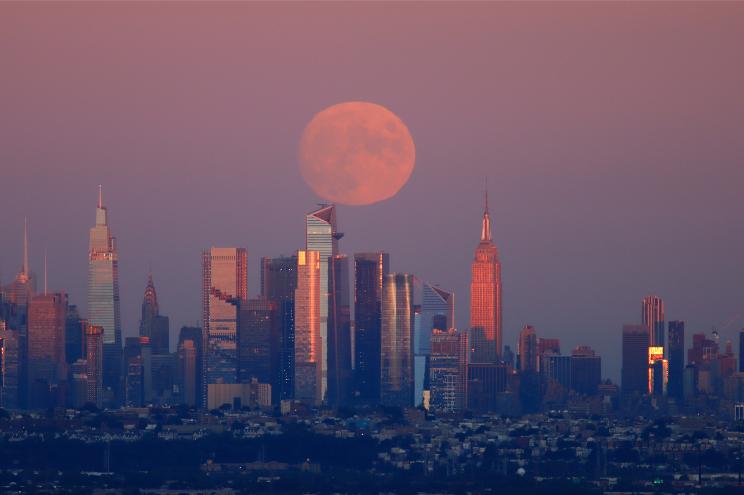Get hyped to howl, folks — the full moon is upon us.
For as long as human beings have had faces to lift to the night sky, we’ve been awed by its lunation. The moon is the fastest-moving celestial body and its cycle governs tides, menstruation, migratory patterns and time.
What does a full moon symbolize?
In astrology, the moon is linked to the divine feminine and our emotional interiority. The date and time of birth determine what sign an individual’s moon falls in. The traits of that sign are made manifest in our emotional energies, reactions to conflict and the kind of love we look for — and are able to provide what we need to feel wholly secure. Moon signs can be found using a birth chart calculator.
What does a full moon mean emotionally?
The full moon occurs when the moon is directly opposite the sun in its orbit around Earth. Spiritually speaking, that opposition — between yin and yang, light and dark — makes for a potent time for surrender and a heightened sense of emotionality. As such, full moons are synonymous with closure and endings; of cycles, habits, relationships.
What does the full moon do to us?
The full moon calls us to release negative or stagnant energy — be it self-loathing or the Ed Hardy T-shirt in your closet. The light of the moon draws out what needs addressing and urges us to take action to expel or correct what we are made to face.
New moon vs. full moon
In contrast, the new moon — occurring when the moon is in line with the sun, and the sun and Earth are on opposite sides of the moon — is a time for beginnings, fresh intentions and clean slates. It is when we plant the metaphorical seeds that we hope will flourish in the days ahead. The new moon is the dark period of the cycle; as such, it allows us to project our desires into and onto a blank and boundless sky.
What are full moon rituals?
Rituals in reverence for both the full and the new moon have been performed since time immemorial. The energy of the moon, depending on the phase, can be called in to help manifest a fledgling dream, call forth a lover, banish an enemy or cauterize an old but aching wound.
Rituals to harness the full moon
If time and temperature allow, basking in the glow of the full moon — on land or ideally in water — is an excellent way to draw in lunar power. Nudity is encouraged, though not required. A full moon ritual bath, replete with soaking salts and candlelight, is a worthy alternative to skinny dipping. Because full moons are about release, writing a list of everything and everyone that no longer aligns with you, reading it aloud and closing with an enthusiastic “Be gone!” is an excellent practice for letting go. Bonus points if you burn the list during a fiery moon, like a full moon in Aries. Because Aries energy is all about unapologetic individualism, worshiping what you love about yourself while surrendering any lingering body shame or negative narrative about your appearance is a perfect recipe for harnessing the medicine of this moon.

Yes, you should howl at the moon
My own preferred, primal way to salute the full moon is with a deep and unabashed wolf howl. Go outside, face the moon and let it out to let it all go. It feels good, it sounds cool and it informs neighbors and strangers that you have immediate access to your inner animal and have little concern for convention.
Regardless of how you choose to dedicate your moon ritual, these ceremonies exist — as they have for ages — to align us with our most essential selves and to develop the relationship between who we are and the power we hold by committing to mindful practices and an integrated life.
In the spirit of integration, the Farmer’s Almanac includes a designation of names related to the Native American practice of describing the moon in terms of the natural world and the shifting seasons within it. October’s full moon is known as the Hunter’s Moon, so named for the time of year when meat is sought and stored for the winter ahead. In the Northern Hemisphere, the Hunter’s Moon is typically celebrated with a formidable feast to honor the harvest and stockpile good times and glad rags for the dark nights ahead.
I heartily recommend a similar kind of revelry: Give thanks for the insistent beating of your own heart, drink to your dead and bow to the ebbs and flows, failures and majesties, roses and thorns that mark the phases of the moon and the days of our lives.
Astrologer Reda Wigle researches and irreverently reports back on planetary configurations and their effect on each zodiac sign. Her horoscopes integrate history, poetry, pop culture and personal experience. She is also an accomplished writer who has profiled a variety of artists and performers, as well as extensively chronicled her experiences while traveling. Among the many intriguing topics she has tackled are cemetery etiquette, her love for dive bars, Cuban Airbnbs, a “girls guide” to strip clubs and the “weirdest” foods available abroad.








